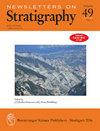Paleogene carbonate systems of Saint Barthélemy, Lesser Antilles: stratigraphy and general organization
IF 2.1
3区 地球科学
Q1 GEOLOGY
引用次数: 12
Abstract
Saint Barthelemy is the only island of the northern Lesser Antilles where it is possible to investigate in the detail the chronostratigraphy of the mixed carbonate-volcaniclastic deposits of the Paleogene Caribbean volcanic arc. Based on field mapping and new biostratigraphical and sedimentological data, we study the limestone units interbedded in the Paleogene volcaniclastic deposits. We find that four main carbonate units occur instead of previously believed six ones. Based on the ages given by the foraminifera assemblages, and taking into account the recently published 40Ar/39Ar ages of magmatic rocks, the Lower Limestone unit dates Lutetian, the Intermediate Limestone unit late (?) Bartonian-late Priabonian, the Upper Limestone late Priabonian and the Top Limestone unit early Miocene. The Paleogene carbonate beds were deposited on gently dipping submarine volcaniclastic deposits issued from emergent volcanoes, in muddy, unrimmed inner to mid-ramp setting dominated by bottom communities. A major subaerial unconformity is evidenced during the Oligocene, most probably corresponding to uplift affecting Saint Barthelemy. Our work offers a revised lithostratigraphic succession of Saint Barthelemy as a first key-point for further studies of the Paleogene Caribbean arc deposits which were dismembered following the entrance of the Bahamas Bank in the Lesser Antilles subduction zone.小安的列斯群岛圣巴塞勒米古近系碳酸盐岩系统:地层学和一般组织
圣巴泰勒米岛是小安的列斯群岛北部唯一一个可以详细研究古近纪加勒比火山弧碳酸盐-火山碎屑混合沉积物年代地层的岛屿。根据野外填图和新的生物地层学、沉积学资料,研究了古近系火山碎屑沉积中互层的灰岩单元。我们发现有四个主要的碳酸盐单元,而不是以前认为的六个。根据有孔虫组合给出的年龄,并考虑到最近公布的岩浆岩的40Ar/39Ar年龄,下灰岩单元的年龄为Lutetian,中灰岩单元的年龄为晚(?)巴尔顿—晚普里阿伯世、上灰岩晚普里阿伯世和上灰岩单元早中新世。古近系碳酸盐岩层沉积于由出露火山形成的缓倾斜海底火山碎屑沉积上,为泥质、无边缘的内-中斜坡环境,以底部生物群落为主。渐新世期间出现了一次主要的陆上不整合,很可能与影响圣巴泰勒米的隆升相对应。我们的工作提供了一个修正的圣巴泰勒米的岩石地层序列,作为进一步研究古近系加勒比弧矿床的第一个关键点,这些矿床是在巴哈马银行进入小安的列斯俯冲带后被肢解的。
本文章由计算机程序翻译,如有差异,请以英文原文为准。
求助全文
约1分钟内获得全文
求助全文
来源期刊

Newsletters on Stratigraphy
地学-地质学
CiteScore
5.50
自引率
4.50%
发文量
22
审稿时长
>12 weeks
期刊介绍:
Newsletters on Stratigraphy is an international, peer-reviewed journal with a focus on stratigraphic issues that are relevant for a broad geoscientific community. Papers published in Newsletters on Stratigraphy use (and ideally integrate) stratigraphic methodologies from a wide field of disciplines, including (but not limited to) biostratigraphy, chronostratigraphy, chemostratigraphy, and magnetostratigraphy.
The results have implications for paleogeographic reconstructions, paleoceanography, paleoclimate, biotic evolution, basin development, or regional and supraregional correlation.
Papers published in Newsletters on Stratigraphy comprise original research articles, background information on ongoing work of e.g., the International Stratigraphic Commission (ICS) and the International Subcommission on Stratigraphic Classification (ISSC), and review articles. There are no page charges for the publication of regular papers.
 求助内容:
求助内容: 应助结果提醒方式:
应助结果提醒方式:


